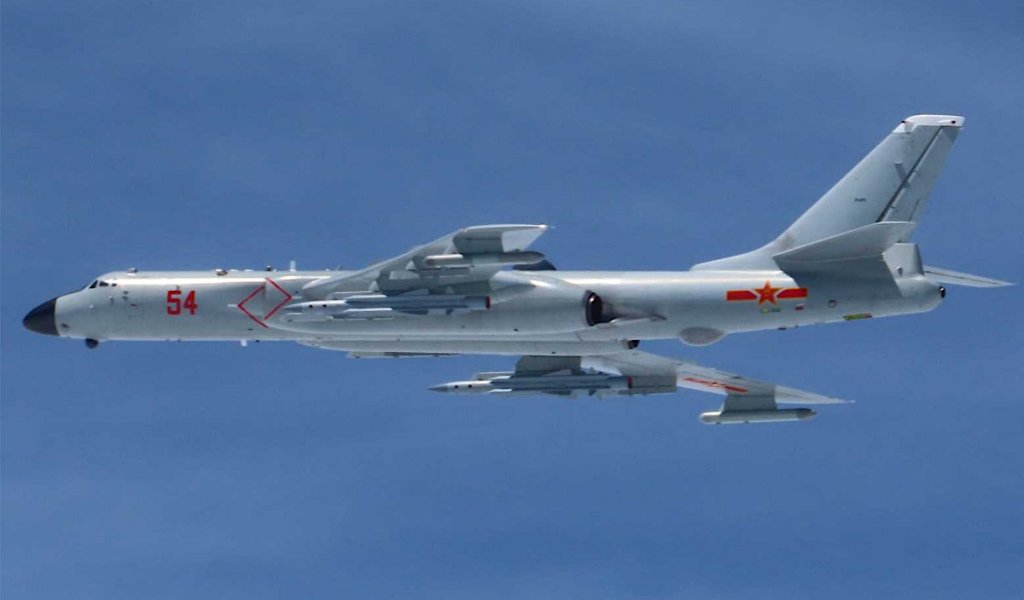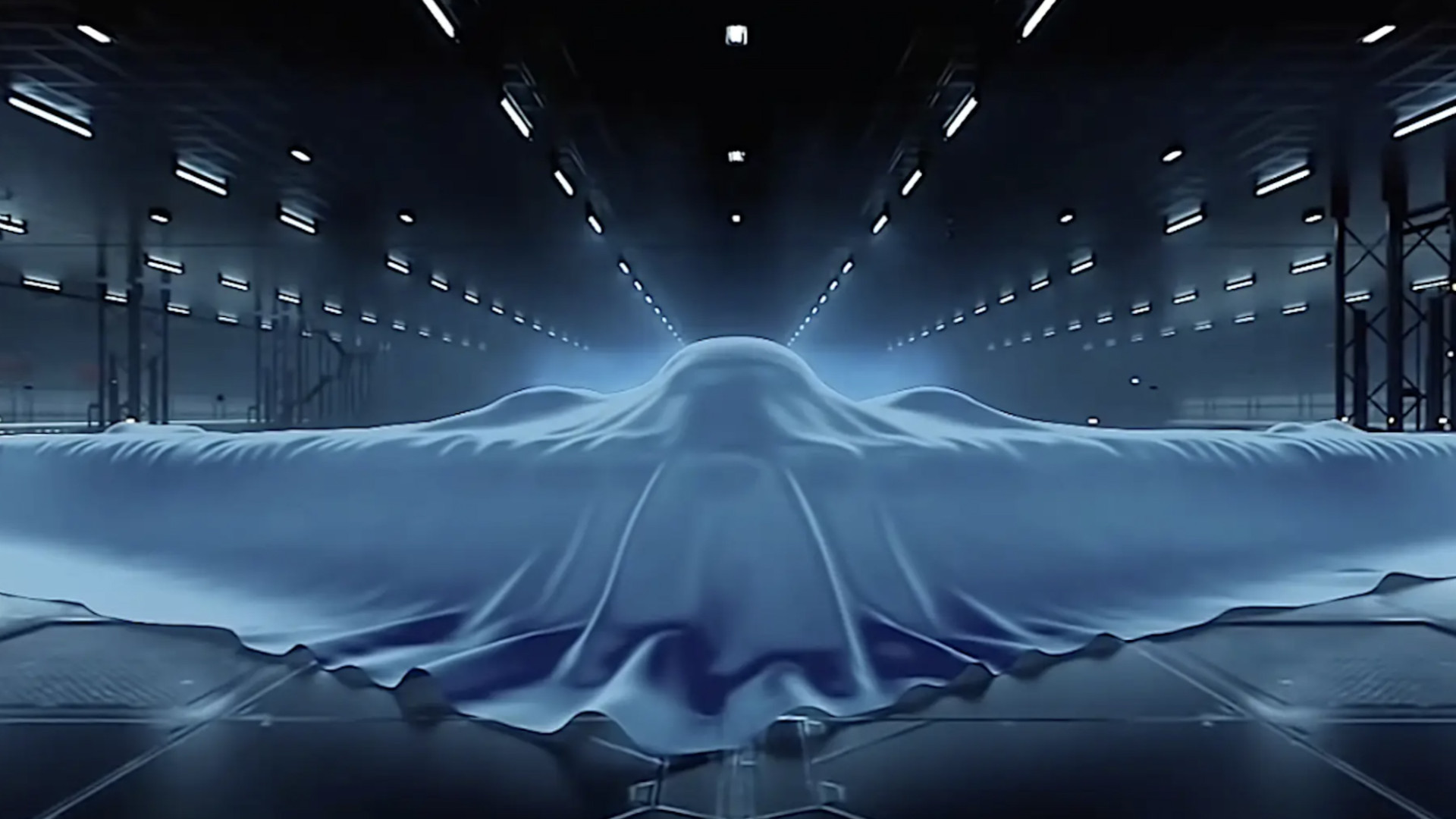The U.S. military says it still does not expect China’s long-awaited H-20 bomber to make its “debut” – unclear if this means its entrance into operational service or just its emergence publicly – until sometime in the next decade. Earlier this year, the People’s Liberation Army Air Force’s (PLAAF) deputy commander was quoted as saying the unveiling of the aircraft, at least, would be coming “soon.” There have been reports for years now that the bomber, expected to be a stealthy flying wing design broadly reminiscent externally of the U.S. B-2 Spirit, could be about to break cover.
A general assessment of the state of the H-20 bomber program is included in the U.S. military’s latest annual report to Congress on Chinese military developments. The Pentagon released an unclassified version of the report today, which also says that the People’s Liberation Army (PLA) is still developing a stealthy medium-ranged bomber referred to in the past as the JH-XX.
The 2021 PLAAF recruitment video below teases the forthcoming H-20 at the very end.

“The PLAAF is seeking to extend its power projection capability with the development of a new H-20 stealth strategic bomber, with official PRC state media stating that this new stealth bomber will have a nuclear mission in addition to filling conventional roles,” the report states. “The PLAAF is developing new medium- and long-range stealth bombers to strike regional and global targets.”
“The PRC is developing a new generation of long-range bombers, likely named the H-20. The H-20, which may debut sometime in the next decade, will have a range of more than 10,000 km [nearly 6,214 miles], enabling the PLAAF to cover the Second Island Chain and into the western region of the Pacific,” another section of the report says. “The H-20 bomber’s range could be extended to cover the globe with aerial refueling. It is expected to employ conventional and nuclear weaponry and feature a stealthy design.”
The Second Island Chain mentioned here refers to an area of the Pacific to the west of a boundary stretching between Japan and eastern Indonesia and includes the U.S. territory of Guam. The remarks here about the H-20 are also largely identical to what the Pentagon included in its China report last year.

“Unfortunately, I can’t really go beyond what appears in the [new China report],” a senior U.S. defense official said at a media pre-briefing earlier this week in response to a question from The War Zone‘s Howard Altman about Chinese bombers. “As you can imagine, we do try to make available as much information as we can, but I’m not able to go beyond what’s in the report for now.”

The latest comments on the H-20 are also in line with what a U.S. intelligence official told multiple outlets about the bomber earlier this year.
“The thing with the H-20 is when you actually look at the system design, it’s probably nowhere near as good as U.S. LO [low observable; stealthy] platforms, particularly more advanced ones that we have coming down,” the intelligent official said during a briefing in April, according to Defense One. “They’ve run into a lot of engineering design challenges, in terms of how do you actually make that system capability function in a similar way to a B-2 or B-21.”

“Not really,” that individual also said when asked if the H-20 presented a concern to the U.S. military, according to Breaking Defense.
A month before, the Chinese state-owned Hong Kong Commercial Daily newspaper had published an interview with Lt. Gen. Wang Wei, deputy commander of the PLAAF, where he was quoted as saying “it’s [the H-20] coming soon, just wait!”
PLAAF’s Lt. Gen. Wang Wei should not be confused with People’s Liberation Army Navy (PLAN) Lt. Cdr. Wang Wei, who died in 2001 while flying a J-8D Finback fighter after colliding with a U.S. Navy EP-3E Aries II spy plane, causing a major international incident that you can read more about here.
“There is no bottleneck [in the H-20’s development], it can be solved,” Lt. Gen. Wang Wei also said, according to the Hong Kong Commercial Daily. “Our scientific researchers are now very good and all have this capability.”
Development of the H-20 is understood to date back to at least the early 2000s. The Xi’an Aircraft Industrial Corporation (XAC), a subsidiary of the state-run Aviation Industry Corporation of China (AVIC), has been leading the project. XAC is also responsible for the many variants of the H-6 bomber, the original version of which was a license-built copy of the Soviet Tupolev Tu-16 Badger, as well as the Y-20 cargo plane, among other designs. Versions of the H-6 make up the PLA’s current long-range aerial strike capabilities.

No official imagery of the H-20 design has emerged to date, though the PLA and AVIC have teased the design for years now. This includes a 2018 AVIC promotional video that aped Northrop Grumman’s famous 2015 Superbowl ad (seen below) teasing what became known as the B-21 Raider. Images of wind tunnel models that could be related to the H-20 program or tangential designs, as well as a slew of speculative fan renderings, have also appeared online in the past.

Past reports have also said the H-20 requirements call for a design capable of carrying up to 10 tons of ordnance, including land-attack and anti-ship cruise missiles, and an unrefueled range of around 5,000 miles (roughly 8,000 kilometers).
Information about the regionally-focused JH-XX, which would have a shorter range and smaller payload capacity than the H-20, is even more scant. You can read more about what is known about that project, which AVIC subsidiary Shenyang Aircraft Corporation, better known for its fighters like the stealthy J-35, may be leading, here.

As The War Zone has highlighted in the past, the H-20 would give the PLA a long-range nuclear-capable aerial strike capability well beyond what it currently possesses with even the latest versions of the H-6 family. That, in turn, would offer the ability to hold entirely new swaths of targets across the Indo-Pacific region, including the highly strategic outlying territory of Guam, Hawaii, and even parts of the continental United States, at risk.
The PLA has already been working in recent years to expand its ability to conduct long-range aerial strikes with H-6 variants. This includes versions capable of launching very large payloads like air-launched ballistic and hypersonic missiles to significantly extend their reach.

In July of this year, a pair of H-6K missile carrier aircraft flew in international airspace near Alaska for the first time ever as part of a joint long-range aerial patrol with Russian forces. However, given the stated maximum range of the H-6K, which is also not capable of being refueled in flight, it is likely that those aircraft conducted their sorties from Russian bases. This underscores the continued limitations of the bulk of the H-6 series, though versions capable of being refueled in mid-air are increasingly being fielded, and the importance of the forthcoming H-20. H-6s are also not low-observable (stealthy) aircraft, while potential air defense threats are only expanding.
The War Zone has also highlighted in the past the value to China of having a stealthy medium-ranged JH-XX ‘bomber,’ which would offer a new and more survivable means of striking targets within the Second Island Chain, as well as in India, from the air. As we’ve written previously:
“With this range, the JH-XX would still have the ability to challenge strategic type targets, such as U.S. military facilities in Japan and possibly even on Guam, as well as bases in India, the South China Sea and beyond. The design could prioritize speed, as well as stealth, too. This could give the smaller fighter-bomber added advantages when it comes to sortie rates and for successfully penetrating through an enemy’s integrated air defense network. Above all else, it allows for multi-role operations, including supporting long-range air-to-air missions, without a heavy reliance on vulnerable tankers or even the use of coastal airfields, which would be the most vulnerable to attack during an all-out conflict.”
When it comes to the H-20, even after a public debut, the PLA would need time to develop a true operational capability with the bombers. Unlike the U.S. Air Force, the PLA still has at best limited experience with very long-range air operations. This is something that the Chinese look to be trying to rectify now through more regular longer-range H-6 flights, particularly in cooperation with Russia. Aerial refueling capacity, which would be key to the H-20 reaching its full potential, is another area where China’s armed forces are still lagging behind the United States, though efforts are underway to change that.

“The biggest … challenge for the Chinese side is actually not so much capability of actual systems, it’s more capability of personnel to effectively employ those systems at speed and at scale. We, as a U.S. military, have a lot of experience fighting wars,” the aforementioned U.S. intelligence official who spoke on H-20 also said back in April per Defense One. “And yes, you talk to any operator, and they’ll tell you all the problems we have, but quite frankly, we’re able to figure out how to execute kill chains. The Chinese don’t really have anybody right now at all, in the PLA, who’s actually been in a war.”
At the same time, “I don’t want to rely on the Chinese not being good,” they cautioned at the time. “Because we’re not going to know they’re not good until they’re shooting at us, and I don’t want to be in a position where I find out, Oh, they actually are that good.”
As The War Zone regularly notes, the PLA continues to make significant strides in the development and fielding of increasingly more modern capabilities across all domains, including in space. This includes significant work on the aerial side, especially in regard to stealthy flying wing-type uncrewed combat air vehicles (UCAV) and other advanced drones. UCAVs are an area where the U.S. military continues to be absent, at least that we know of, despite an increasingly global resurgence of work on such designs.
The U.S. military does say China is still actively pursuing both the H-20 and the JH-XX, even though they are still likely years away from becoming a reality.
Contact the author: joe@twz.com
